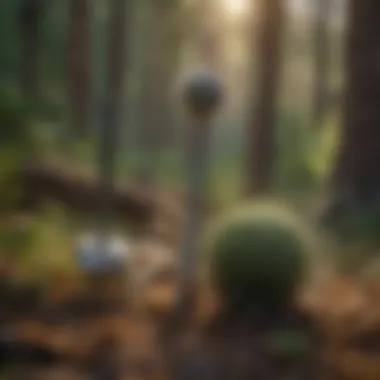Effective Strategies for Eradicating Thistles


Intro
Thistles, an often underestimated group of plants, present significant challenges in various ecosystems, especially in American forests. Their robust and invasive nature allows them to thrive in many environments, causing disruptions that affect local flora and fauna. Understanding effective strategies for managing thistle populations necessitates a deeper exploration of their biology and behavior. This article aims to provide valuable insights into practical methods for eradicating thistles through cultural, mechanical, and chemical approaches. Each strategy will be evaluated for its effectiveness, potential benefits, and any environmental impacts it may harbor. Exploring these diverse management techniques fosters a holistic understanding, equipping individuals to combat thistle issues in a sustainable manner.
Understanding Thistles
To address the issue of thistles effectively, one must first understand the fundamental aspects of these plants. Thistles, particularly invasive species, can propagate quickly and impact local ecosystems negatively. This section explores the classification, lifecycle, and ecological impacts of thistles, laying the groundwork for effective management strategies.
Classification of Thistles
Thistles belong to the family Asteraceae, characterized by their spiky appearance and vibrant flowers. Common types include Canada thistle (Cirsium arvense), bull thistle (Cirsium vulgare), and milk thistle (Silybum marianum). Each type varies in growth habits and habitat preferences. Understanding the classification helps in identifying thistle species, which is essential for applying targeted control measures.
Lifecycle and Growth Habits
Thistles exhibit a biennial or perennial lifecycle, depending on the species. In general, biennial thistles grow as rosettes in the first year, with flowering occurring in the second year. This growth strategy allows them to establish a strong root system before reproduction. Perennial thistles can live for multiple years, continuing to regrow after being damaged or cut. Their rapid growth and ability to thrive in disturbed soils complicate management efforts. Recognizing their growth habits is vital for effective intervention.
Ecological Impact of Thistles
Thistles can have profound ecological consequences, particularly when they invade natural habitats. They compete aggressively with native plants for resources, often leading to reduced biodiversity. Moreover, their dense growth can alter local soil conditions and hydrology. As a result, the overall health of the ecosystem may decline. Understanding these impacts is crucial for anyone involved in land management or conservation efforts.
Effective thistle management not only preserves native flora but also maintains the health of entire ecosystems.
By comprehensively understanding thistles—how they are classified, their lifecycle, and their ecological roles—land managers can make informed decisions about their control. This knowledge serves as a foundation for exploring various strategies to mitigate the problems posed by these invasive plants.
Assessing the Thistle Problem
Assessing the thistle problem is a critical step in managing these invasive plants. Understanding how to evaluate thistle infestations provides a foundation for developing effective control strategies. It offers a structured approach to identifying specific challenges and establishing priorities. By thoroughly assessing the problem, stakeholders can make informed decisions on interventions needed to reduce thistle populations.
Identifying Thistle Infestations
Identifying thistle infestations involves observing key characteristics of the plants. Proper identification is essential because different species of thistles may require varied management approaches. These invasive plants typically exhibit a range of growth patterns and colorations that distinguish them from other flora.
Regular inspections of areas prone to thistle growth can help catch infestations early. Focus on looking for:
- Distinctive spiny leaves
- Purple or white flowers, depending on the species
- Growth habits that form small patches or large clusters
Utilizing field guides or online resources can aid in proper identification. For example, resources such as the Encyclopedia Britannica or agricultural extension services often have comprehensive descriptions and images. By pinpointing the species at hand, land managers can tailor their strategies for maximum effectiveness.
Determining the Severity of Infestation
Once thistles are identified, determining the severity of the infestation is the next logical step. This assessment involves more than just counting individual plants; it requires evaluating the density of the infestation and its potential to spread. When assessing severity, consider factors such as:
- The percentage of the area occupied by thistles
- The size and maturity of the plants present
- Proximity to desirable plants that may be impacted
A systematic approach can help quantify the infestation's severity:
- Mapping infested areas: Creating a visual representation on a map can aid in visualizing extent and planning control measures.
- Monitoring over time: Regular assessments allow for tracking changes and identifying trends in thistle populations.
- Evaluating risk: Consider how the infestation might affect surrounding ecosystems, crops, or land uses.
"A thorough assessment not only highlights the immediate issues but also informs future management decisions."
Collecting this data is essential for developing a response strategy that is both effective and sustainable. Ultimately, assessing thistle infestations lays the groundwork for control methods that align with best management practices.
Cultural Control Methods


Cultural control methods play an essential role in managing thistle populations in various settings. These methods rely on altering farming or land management practices to create conditions that discourage the growth of thistles. The implementation of cultural strategies can provide long-term solutions that reduce the reliance on chemicals, thus protecting the environment. By optimizing soil health, diversifying cropping systems, and promoting competitive plant communities, land managers can effectively mitigate thistle infestations.
Soil Management Techniques
Soil management is foundational for controlling thistles. Healthy soil promotes robust plant growth, which can outcompete thistles. Key techniques include:
- Maintaining Soil Fertility: Regular testing helps identify nutrient deficiencies. Applying organic matter like compost can enhance soil structure and nutrient content.
- Adjusting pH Levels: Thistles often thrive in certain pH ranges. Soil amendments, such as lime or sulfur, can bring pH to optimal levels for desired crops and hinder thistle growth.
- Preventing Soil Compaction: Compact soil restricts root development of desirable plants. Employing cover crops and avoiding heavy machinery during wet conditions can maintain soil structure.
Implementing good soil management practices creates an environment less favorable to thistles and supports sustainable agricultural systems.
Crop Rotation Strategies
Crop rotation is an effective cultural method for thistle control. It disrupts the lifecycle of thistles by changing the type of plants grown in a particular area, thus reducing their prevalence. Important considerations include:
- Diverse Crop Selection: Rotating crops such as grains, legumes, and grasses interrupts thistle reproduction cycles. Each crop has different growth habits, which can significantly disrupt thistle's establishment.
- Seasonal Timing: Planting winter crops can resurface thistles that thrived in summer. Delaying the planting of certain crops can also weaken thistle root systems.
- Integrating Perennial Crops: Including perennial crops in rotation can enhance weed suppression because their deep roots improve soil health.
Incorporating a well-planned crop rotation strategy can lead not only to better management of thistles but also to improved yields and soil health over time.
Cover Cropping for Thistle Suppression
Cover cropping serves as a vital technique for thistle management. Cover crops can suppress thistle growth while offering additional benefits such as soil erosion prevention and nutrient retention. To effectively use cover crops:
- Select Competitive Varieties: Choose cover crops that establish quickly and create thick growth. Species like rye or clover can suppress thistles by shading and competing for nutrients.
- Timing of Planting: Plant cover crops immediately after harvest to minimize thistle germination. Early establishment gives cover crops a competitive edge over thistles.
- Proper Termination: Ensure that cover crops are terminated effectively before planting the main crop. This management prevents thistles from re-establishing and takes advantage of the nutrients released by decomposing cover crops.
Cover cropping is a strategic approach that not only reduces thistle populations but also enhances overall soil health.
Mechanical Control Techniques
Mechanical control techniques play a crucial role in managing thistle populations. These methods utilize physical tools and practices to reduce thistle growth without relying heavily on chemicals. They offer several benefits including immediate reduction of thistle presence, minimal risk to surrounding plant life, and the prevention of herbicide resistance. Understanding these techniques helps in creating a well-rounded approach to thistle management.
Mowing and Cutting Practices
Mowing is an effective method for controlling thistles, especially for mature plants that have already developed seeds. It is best practiced before thistles reach full bloom to prevent seed dispersal. Regular mowing can deplete the plants’ energy reserves and hinder their growth over time. Cuttings should be set at a height that effectively removes the flowering tops while avoiding damage to the grass or desired vegetation nearby.
Some key points to keep in mind while using mowing as a control method include:
- Timing: Mow when plants are small and before flowering.
- Frequency: Regular mowing over several growing seasons is necessary to deplete root reserves.
- Disposal of Clippings: Always dispose of thistle clippings properly to prevent re-establishment.
Tilling and Soil Disruption
Tilling and soil disruption are methods that can be beneficial in thistle management, although they must be used with caution. This technique disrupts the root systems of established thistles, making it harder for them to survive and regrow. Tilling can also expose thistle seeds to adverse conditions, reducing their viability. However, it is important to note that tilling can also disturb other soil ecosystems and encourage the germination of other weed species if not managed correctly.
- Timing: Implement tilling in early spring or late fall when thistles are actively growing.
- Technique: Combine shallow tilling to disturb surface roots with deeper tilling to reach those well-established roots.
- Follow-up Actions: After tilling, consider other control methods to manage newly exposed thistle seeds effectively.
Hand Weeding Applications
Hand weeding is a straightforward but effective mechanical control method. This approach involves manually removing thistles from the root system, which is vital for preventing regrowth. However, this method requires careful attention to detail and consistent effort. It is most effective in small infestations or in areas where mechanical machinery cannot reach.
Key considerations for hand weeding include:
- Timing: Weeding should occur when the ground is moist, making it easier to pull out the entire root.
- Tools: Tools such as hand trowels or weeders can assist in removing larger roots.
- Ongoing Vigilance: Hand weeding requires regular follow-ups, as new plants may emerge after disturbance.
"Mechanical methods, when carried out correctly, can significantly reduce thistle infestations, fostering healthier environments for other plants."
In summary, mechanical control techniques provide effective options for thistle management. When combined with other strategies, such as cultural or chemical control, they create a holistic approach to managing these invasive plants. Each method has its own benefits and limitations, reminding us that addressing thistle issues often requires multifaceted solutions.


Chemical Control Options
Chemical control options are critical for managing thistle infestations effectively. This approach involves the use of herbicides to target thistles directly. It provides a means to rapidly reduce thistle populations, particularly in situations where other methods may be less effective. Understanding how to use chemical treatments responsibly is essential.
Herbicides: Types and Applications
Herbicides can be categorized based on their action. Some common types include:
- Pre-emergent herbicides: These prevent thistle seeds from germinating. Applying them before thistle emergence is necessary for success.
- Post-emergent herbicides: These work on actively growing thistles. They are applied after thistles have emerged and should ideally target the foliage directly.
The application method also plays a significant role. Spraying, drenching, and soil application techniques will vary in effectiveness depending on the formulation and the type of thistle present. Timing is another critical factor; early application can prevent thistle spread effectively.
Selective vs. Non-selective Herbicides
Understanding the difference between selective and non-selective herbicides is vital.
- Selective herbicides are designed to target specific plant species, leaving desirable plants unharmed. This property is crucial in environments where maintaining biodiversity is a concern.
- Non-selective herbicides kill all plants they come into contact with. These are often effective for initial thistle removal in areas where other plants can be temporarily sacrificed.
The choice between these options depends on the surrounding environment and the level of thistle infestation. Generally, selective herbicides are a better option for integrated pest management, while non-selective herbicides might be more useful in heavily infested or controlled areas.
Safety Precautions When Using Chemicals
When applying any chemicals, careful consideration of safety is paramount. Here are several key precautions to follow:
- Always read and follow the label instructions completely.
- Use personal protective equipment such as gloves, masks, and goggles to avoid exposure.
- Apply the product during calm weather to minimize drift to non-target areas.
- Keep pets and children away from treated areas until it is safe.
Important: Failure to comply with safety regulations can lead to not only personal harm but also environmental damage. Ensuring correct application is crucial for sustainable management.
Integrated Pest Management (IPM) Approaches
Integrated Pest Management (IPM) is a holistic approach that combines various control strategies to effectively manage thistle populations. The significance of IPM lies in its ability to address thistles in a sustainable way. Using a mixture of cultural, mechanical, and chemical methods, IPM helps reduce the reliance on any single method, thus minimizing negative environmental impacts. IPM also focuses on preventing thistle infestations from occurring in the first place, rather than just responding to existing problems. This preventive stance emphasizes long-term solutions and helps maintain the ecological balance of forest ecosystems.
Combining Control Methods
A core tenet of IPM is the synergy achieved by combining multiple control methods. For instance, integrating mechanical control techniques, like mowing, with cultural practices, such as crop rotation, creates a multifaceted barrier against thistles. Different methods can target thistles at various stages of their lifecycle. This integrated approach not only increases the effectiveness of control measures but also delays the development of thistles' resistance to certain treatments.
Effective combinations can include:
- Mechanical Control + Cultural Practices: Mowing thistles before they set seed, followed by rotating crops to disrupt their growth cycle.
- Cultural Practices + Chemical Treatment: Improving soil health through cover cropping before applying selective herbicides.
- Monitoring: Assessing thistle populations to time interventions more effectively.
The idea here is to create multiple lines of defense against these invasive plants. By not relying on a single strategy, you also lower the chances of unintended consequences that can arise from overusing any one method.
Monitoring and Evaluation of Control Effectiveness
Monitoring is a critical component within the IPM framework. After implementing control strategies, continuous observation is essential to assess their effectiveness. Identifying what works and what does not informs future management decisions and makes the approach adaptable to changing conditions. Evaluation can involve field surveys, analysis of thistle population dynamics, or assessing recovery of native species in treated areas.
Here are some key aspects to consider during monitoring:
- Regular Site Inspections: Document changes in thistle populations over time.
- Data Collection: Maintain records of treatments applied and their outcomes to find patterns in effectiveness.
- Adjust Strategies as Needed: Use collected data to refine and adapt control measures based on observed results.
"Effective monitoring not only reveals the success of control methods but also aids in adjusting management practices for future interventions."
This ongoing evaluation ensures that the IPM approach remains both effective and responsive to the dynamic challenges posed by thistle infestations. By emphasizing monitoring, the IPM strategy cultivates an adaptive management mindset, enabling professionals to make informed decisions suited to their unique challenges.


Long-term Prevention Strategies
Long-term prevention strategies play a critical role in managing thistle infestations. These strategies focus on reducing the likelihood of thistle resurgence after initial control efforts. By establishing a sound ecological foundation, the invasive nature of thistles can be mitigated. Successful long-term prevention requires a multi-faceted approach, integrating various ecological principles and practices.
Enhancing Soil Health
Soil health is essential for fostering a resilient ecosystem. Healthy soil supports the growth of beneficial plants while suppressing invasive species like thistles. One method to enhance soil health includes applying organic matter, such as compost or well-rotted manure. This practice improves nutrient availability and microbial activity.
Key Actions:
- Regularly test soil to identify nutrient deficiencies.
- Implement cover cropping to prevent erosion and enhance organic matter.
- Avoid over-relying on chemical fertilizers, which can deteriorate soil biology.
These practices not only improve soil structure but also create unfavorable conditions for thistles to thrive. Resilient soil promotes healthy plant communities that can naturally outcompete thistles.
Establishing Healthy Plant Communities
Developing heterogeneous plant communities is crucial for reducing thistle prevalence. Diverse plant assemblages create competition, shading, and allelopathy, which are all effective in suppressing thistle establishment. Native species are particularly advantageous in this respect, as they are well-adapted to local conditions and provide habitat for beneficial organisms.
Considerations for Establishing Plant Communities:
- Use native vegetation in landscaping to promote biodiversity.
- Consider planting deep-rooted species which can improve soil structure.
- Regular monitoring is key to ensure plant community health and diversity is maintained.
This biodiversity increases ecosystem resilience, making it harder for thistles to re-establish.
Implementing Sustainable Land Management Practices
Sustainable land management is essential in preventing thistle outbreaks. This involves practices that protect the environment, promote agricultural productivity, and maintain community health. Crop rotation, reduced tillage, and integrated pest management are all part of this approach.
Practical Steps for Sustainable Practices:
- Rotate crops annually to break thistle life cycles and reduce seed banks.
- Adopt minimum tillage practices to prevent soil disturbance that may stimulate thistle growth.
- Encourage natural predators and beneficial insects through habitat creation and reduced pesticide use.
These practices create a holistic environment where thistles struggle to compete, making prevention comprehensive and effective.
Successful long-term thistle management relies on the proactive combination of soil health, diverse plant communities, and sustainable practices.
Epilogue
The importance of concluding an article on thistle management cannot be overstated. It serves as a capstone to the extensive strategies laid out for eradicating thistles while reinforcing why effective management is crucial for land health and biodiversity.
Summary of Control Strategies
In this section, we can summarize the various approaches discussed previously. Three primary categories highlight the management of thistles: cultural, mechanical, and chemical methods. Cultural control focuses on soil health and planting practices designed to keep thistles at bay. This includes crop rotation and cover cropping, which disrupt thistle lifecycle and competitive advantage. Mechanical control involves physical techniques such as mowing, tilling, and hand weeding to disrupt growth. Chemical control utilizes herbicides, selecting between non-selective and selective options, always keeping safety as a priority when applying them.
Key strategies include:
- Staying vigilant in identifying thistle species to ensure effective response procedures.
- Combining several methods for an integrated approach to increase efficiency and reduce the chances of thistle regrowth.
- Monitoring environmental impacts to ensure long-term sustainability.
Each control strategy brings its strengths and weaknesses, making a nuanced approach necessary.
Future Directions in Thistle Management
The exploration of future directions in thistle management is essential as environmental conditions continue to change. Emerging research focuses on improving the efficacy of existing methods. Innovations in genetic modification are being explored to create crop varieties more resistant to thistle invasions. Additionally, biological control, using natural predators of thistles, is gaining traction as a sustainable alternative to chemical application.
Strategies for enhancing soil health can evolve by incorporating more diverse planting alongside indigenous species, which can outcompete thistles.
The role of technology in monitoring thistle infestations is also growing. Utilizing drone technology and satellite imagery can assist land managers in identifying areas of concern more efficiently.
The future will likely require collaboration among forestry professionals, researchers, and policymakers to develop comprehensive management plans that adapt to ongoing ecological changes.
Understanding these factors and integrating them into management strategies will be crucial in the fight against thistles.



